It looks like you're using an Ad Blocker.
Please white-list or disable AboveTopSecret.com in your ad-blocking tool.
Thank you.
Some features of ATS will be disabled while you continue to use an ad-blocker.
share:
Probably decorative or having a symbolic meaning that is lost to us.
If one were to investigate the literature you'll probably find a mention of this as symbols are like candy to archaelogists and ethnologists, they cannot resist. I'd suggest showing these to Andeanist too
If one were to investigate the literature you'll probably find a mention of this as symbols are like candy to archaelogists and ethnologists, they cannot resist. I'd suggest showing these to Andeanist too
edit on 9/10/11 by Hanslune because: (no reason given)
Originally posted by Trueman
reply to post by Char-Lee
I think you posted it in the wrong thread.
Sure did...somehow.
Thanks and sorry must have been reading both at once.
reply to post by Trueman
I doubt this is writing. Looks more like slots for decorations or something.
I doubt this is writing. Looks more like slots for decorations or something.
Originally posted by kdog1982
Why are people starring and flagging with no input?
a
Not to be rude, but, are you SERIOUSLY that dense that you can't think of a reason you have witnessed this phenomena????
Some people may not be knowledgeable on the topic although they are interested in it and would like to do the OP, and themselves, a favor by flagging and starring the topic in hopes to garner some attention to this thread and maybe attract someone who is fortunate enough to have spent enough time studying this area to be able to take a stab at it, and they don't happen to be one of those annoying people who HAVE to post on EVERY thread they click on, taking up space and inflating the size of the thread for those who might come later to have to pour through page after mind-numbing page just for a little tidbit of actual info here and there when half the posts consist of something really lame, like the idiots who always say something like "It says "dont forget to drink your ovaltine." As they are Guffawing all over themselves... I KNOW someone will say it in this thread sooner or later...
And I could list several other reasons why people would flag and/or star without posting, but I don't have time and the above waste of time should get a good general picture through your thick skull (hehe I'm just kidding haha all in good fun, bud)
To the op, I agree, the first thing I thought it looked like was a form of Hebrew or something! Great minds think alike?? hehe
^^^^^^ This last part of my post is the type of unnecessary post (causing others who might actually be knowledgeable on the subject, and thus helpfull, to have to wade through an endless sea of crap I was referring to in the first part of my post. I only added it in because I had to post something that was on topic! And to show you the result when someone insists on making a post when they really have nothing to say, and a simple star and or flag would say it all: "I agree with the op"
Originally posted by Gorman91
reply to post by Trueman
I doubt this is writing. Looks more like slots for decorations or something.
Pre-inca and inca civilizations used patterns displayed in a simetrical way, usually repeating the same figure. Like the walls of Chan Chan (Chimu Empire) :
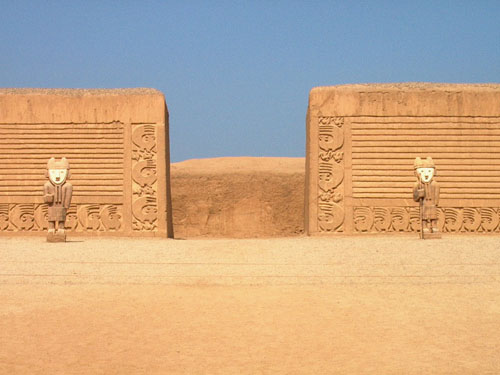
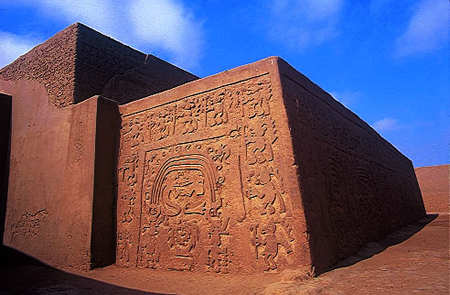
or the textiles of Paracas Culture :
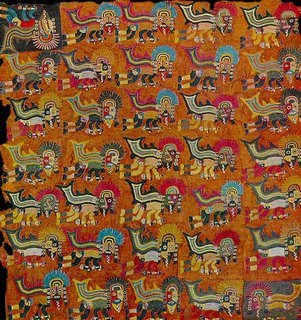
img.abovetopsecret.com...
Also, the icons used for these cultures mostly represent an animal, god or any other specific concept itself.
As you can clearly see, the wall I presented in my thread has very different characteristics. For that reason, I don't believe those symbols are simple decoration.
edit on 9-10-2011 by Trueman because: (no reason given)
reply to post by Trueman
Decoration evolves. It's not writing because it repeats too much. Imagine each symbol was a letter. You'd essentially have ddhhhfffnnneeeffmm. That's not going to be a word. Not in any language. Language is precise, simple, and to the point.
Slots for something or decoration makes more sense. And just because they are not similar to another doesn't mean it's not decorations. Just look at the diversity of styles in England alone from the prehistory times. Very unique as you go from tribe to tribe.
Decoration evolves. It's not writing because it repeats too much. Imagine each symbol was a letter. You'd essentially have ddhhhfffnnneeeffmm. That's not going to be a word. Not in any language. Language is precise, simple, and to the point.
Slots for something or decoration makes more sense. And just because they are not similar to another doesn't mean it's not decorations. Just look at the diversity of styles in England alone from the prehistory times. Very unique as you go from tribe to tribe.
reply to post by Gorman91
They don't need to be "letters" or "words" necessarily. Those symbols could represent the moon phases, a calendar or sea tides, just to give you an example. Remember there isn't records of any written language in the area, and even the incas used the "quipus" or "kipus" system as the only way to store information. The kipus doesn't use letters or words neither, each "knot" represents an specific and detailed concept, for example, a single knot could mean a certain amount of alpacas, of an specific color.
Regarding the decoration theory, Huaycan had been studied for years and arqueologist still are not sure of the meaning of those symbols, there is no symmetry or pattern. Also, I repeat, the other adjacent walls in Huaycan have decorations displayed in the tradicional way, with totally different designs from the wall in discussion.
Certainly, you are not the only one who believe the symbols could be decoration, but the evidence doesn't support such a theory.
They don't need to be "letters" or "words" necessarily. Those symbols could represent the moon phases, a calendar or sea tides, just to give you an example. Remember there isn't records of any written language in the area, and even the incas used the "quipus" or "kipus" system as the only way to store information. The kipus doesn't use letters or words neither, each "knot" represents an specific and detailed concept, for example, a single knot could mean a certain amount of alpacas, of an specific color.
Regarding the decoration theory, Huaycan had been studied for years and arqueologist still are not sure of the meaning of those symbols, there is no symmetry or pattern. Also, I repeat, the other adjacent walls in Huaycan have decorations displayed in the tradicional way, with totally different designs from the wall in discussion.
Certainly, you are not the only one who believe the symbols could be decoration, but the evidence doesn't support such a theory.
Those symbols HAD a meaning; old images always do. Remember that before letters, there were ideograms to communicate. Those ideograms, like the
first letters ( and, actually, modern letters too ) represent something.
So, on the wall, we may not be seeing something like "AAANNNNEEEEEDDDDAAA", as a previous poster said, but something like "God God God, Protection Protection Protection Life Life Life..."...
So, on the wall, we may not be seeing something like "AAANNNNEEEEEDDDDAAA", as a previous poster said, but something like "God God God, Protection Protection Protection Life Life Life..."...
Originally posted by kdog1982
Why are people starring and flagging with no input?
I am currently researching it,I will be back.
www.arqueologiadelperu.com.ar...
Some sort of decoration?
If you have google it will translate it for you.edit on 8-10-2011 by kdog1982 because: (no reason given)
From your link it looks to me (and when you compare the other images) like a way of distinguishing buildings as they all pretty much, from eye level height, looked the same, eg color, construction etc.
Perhaps even using symbols and pictures, which are different in some of those pics, to indicate a meaning or a name. Like signage in our time, so to speak to advertise who/what you are.
I see the connection with the Hebrew, but one of the signs is completely back the front, with no equivalent in the language, so that's a stretch.
Interesting though...
s&f
Originally posted by AussieAmandaC
I see the connection with the Hebrew, but one of the signs is completely back the front, with no equivalent in the language, so that's a stretch.
Interesting though...
s&f
Maybe it is because after some time, being separated from the Old Continent, language, as any other thing, evolved and we see part of that evolution with Hebrew like letters being rotated, with new symbols being created, to describe what wasn't on the Old Continent but was/is on the new one.
I like your idea it could have been to advertise some function of the buildings. Interesting indeed!
I can not comment on the history of the site or for that matter the 'evolution' of Hebrew language, I don't know enough.
It is only from my own personal visual point of view looking at the images supplied in your link.
Upon further comparison the three images showing the designs are very dissimilar also, in that the level of skill for the finish and detail doesn't match, which then springs to mind... graffiti, old, but still not in line with the other two set of patterns.
Ahhh if only stone could talk hey?
It is only from my own personal visual point of view looking at the images supplied in your link.
Upon further comparison the three images showing the designs are very dissimilar also, in that the level of skill for the finish and detail doesn't match, which then springs to mind... graffiti, old, but still not in line with the other two set of patterns.
Ahhh if only stone could talk hey?
reply to post by Trueman
Well I suppose I consider moon phases and the lot to be decorations, to be honest. And this idea of a single knot or detail meaning something is sort of like a child's secret language. Exceedingly complicated and only lasts a short time before something easier to remember is preferred.
In architecture we use diagrams to show things that (hopefully) would be universally understood. The scientists of the voyager probe did this same concept in creating the "golden record' diagram. But all of these have some sophistication. These markings do not. They are basically 3 symbols repeated. Pointless because they show no information.
Well I suppose I consider moon phases and the lot to be decorations, to be honest. And this idea of a single knot or detail meaning something is sort of like a child's secret language. Exceedingly complicated and only lasts a short time before something easier to remember is preferred.
In architecture we use diagrams to show things that (hopefully) would be universally understood. The scientists of the voyager probe did this same concept in creating the "golden record' diagram. But all of these have some sophistication. These markings do not. They are basically 3 symbols repeated. Pointless because they show no information.
For a larger perspective here is another pic.
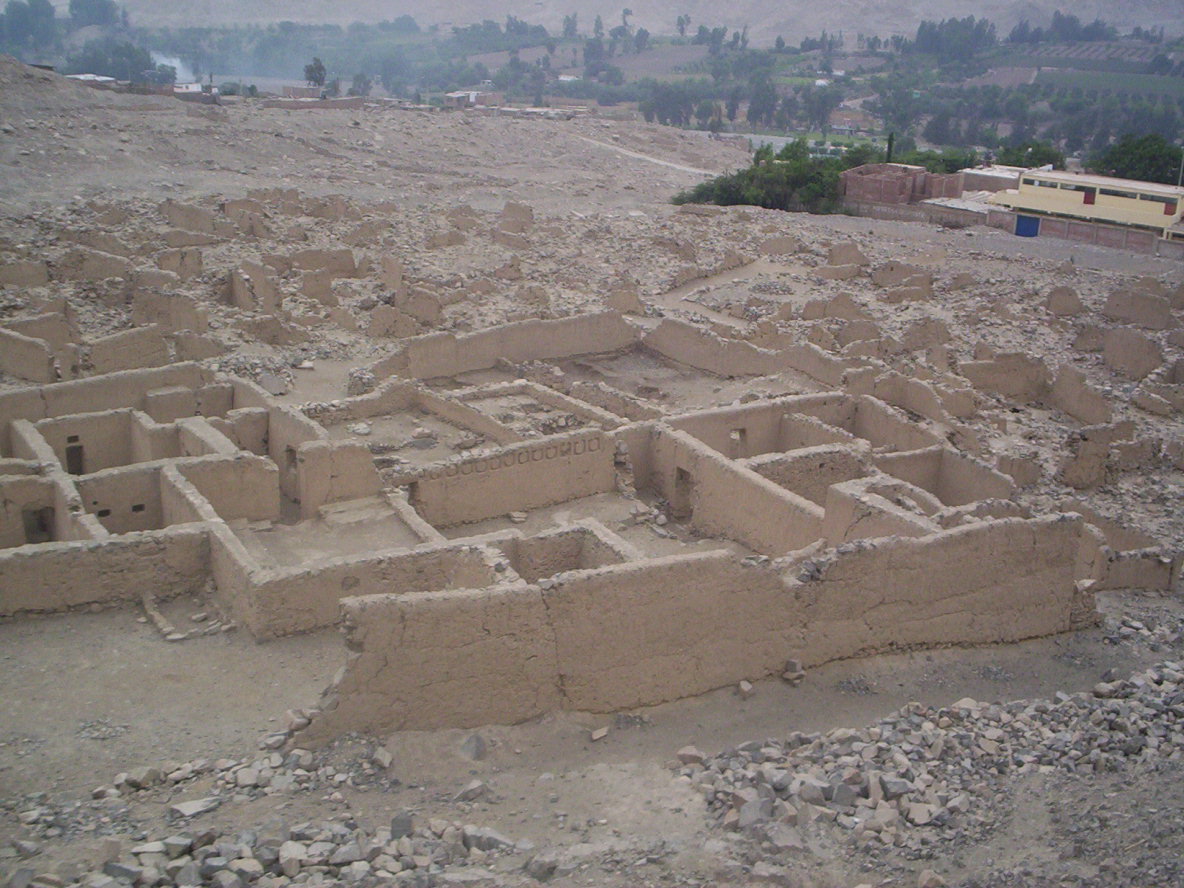
We see an inside wall with more inscriptions. Here are some more.
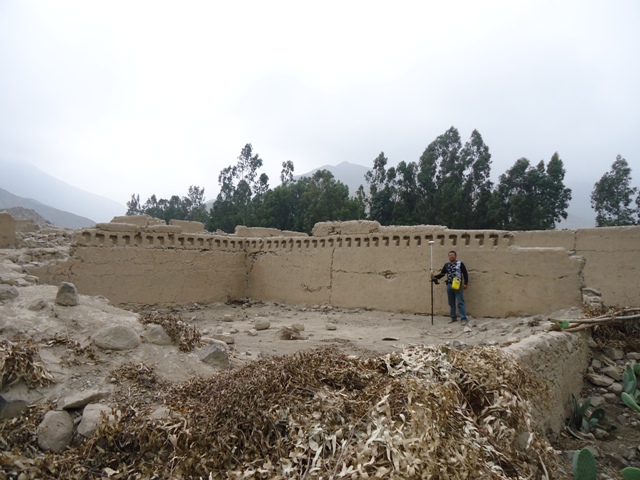

"Some authors associate these friezes of agriculture and new moons, for example, in the picture, representing the full moon. "
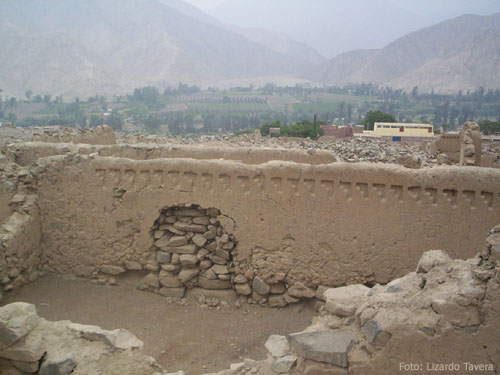
" Friezes in relief with a motif in the form of three-step ladder inverted "negative", which leaves opsición in "positive" another step design that is interpreted as the fourth part of a "chakana" (Andean Cross). "
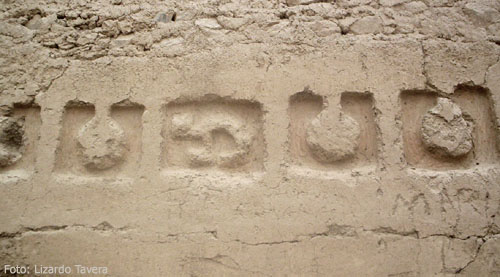
" Frieze of the puma. At the center of a sequence of circular designs (full moon), a design that would represent a cat, identified by some as a cougar, animal related to water and agriculture.
Source

We see an inside wall with more inscriptions. Here are some more.


"Some authors associate these friezes of agriculture and new moons, for example, in the picture, representing the full moon. "

" Friezes in relief with a motif in the form of three-step ladder inverted "negative", which leaves opsición in "positive" another step design that is interpreted as the fourth part of a "chakana" (Andean Cross). "

" Frieze of the puma. At the center of a sequence of circular designs (full moon), a design that would represent a cat, identified by some as a cougar, animal related to water and agriculture.
Source
Thank you Julie for the photographs
The repetition of the same symbol is probably decorative or it could stand as a symbol which is repeated for decorative/religious affect. The modifications from straight decorative to the inclusion of different art may just be an artistic interpretation.
Interesting nonetheless!
The repetition of the same symbol is probably decorative or it could stand as a symbol which is repeated for decorative/religious affect. The modifications from straight decorative to the inclusion of different art may just be an artistic interpretation.
Interesting nonetheless!
reply to post by Hanslune
The repetition of a symbol in a wall could mean that the room is dedicated to an specific function or ceremony.
The repetition of a symbol in a wall could mean that the room is dedicated to an specific function or ceremony.
Originally posted by Gorman91
reply to post by Trueman
Well I suppose I consider moon phases and the lot to be decorations, to be honest. And this idea of a single knot or detail meaning something is sort of like a child's secret language. Exceedingly complicated and only lasts a short time before something easier to remember is preferred.
The "kipus" were far from be considered a "child secret language". The whole government of the Inca's Empire was based in the records kept with this method.

Currently, most investigators consider the kipu to have been the 'written' language of the Inca people. The kipucamayocs were the database administrators, so to speak, and were the only ones capable of interpreting the meaning of the knotted strings, based on the color (e.g. yellow for gold, red for army), positioning and type of the different knots.
The knots were made in a base-of-10 positional notation that even shows the use of the zero and they could mean anything from the number of babies born in a village to the amount of corn that was distroyed in a hail storm; all depending on the context they were used in.
Some scientists believe they were also used as memory aids for storytellers or poets.
Sadly enough however, since the kipus were closely related to the Inca culture and religion and because the Spanish conquistadores presumably did not understand much of it, they were considered a threat and therefore erradicated as thoroughly as possible.
This may mean that a part of the knowledge about kipus will forever be lost in history.
www.kipu.be...
edit on 10-10-2011 by Trueman because: (no reason given)
reply to post by Trueman
I don't really see that as a language though. Even the article says its more for memory aid. More akin to a rosary bead or something. Sure yea that's a kind of language in and of itself, but to say that is a language, like you and I use, I don't see how.
I mean just for example, there are a ton of stories in my head. And the way I keep them for being forgotten is that every here and there I'll see something that reminds me of it and then play out a scene in my head, or simply pick one and try to dream it. That's not really a language. Writing it down would be.
I don't really see that as a language though. Even the article says its more for memory aid. More akin to a rosary bead or something. Sure yea that's a kind of language in and of itself, but to say that is a language, like you and I use, I don't see how.
I mean just for example, there are a ton of stories in my head. And the way I keep them for being forgotten is that every here and there I'll see something that reminds me of it and then play out a scene in my head, or simply pick one and try to dream it. That's not really a language. Writing it down would be.
new topics
-
Plane Crash in South Korea
Mainstream News: 10 hours ago
top topics
-
Cutting Boards
Food and Cooking: 13 hours ago, 8 flags -
Plane Crash in South Korea
Mainstream News: 10 hours ago, 8 flags -
Mexico Plans Alert App For Migrants Facing Arrest In US
Mainstream News: 14 hours ago, 6 flags
active topics
-
Trump's idea to make Canada the 51st US state: 'Potential is massive'
Mainstream News • 108 • : Xtrozero -
Kurakhove officially falls. Russia takes control of major logistics hub city in the southeast.
World War Three • 20 • : fringeofthefringe -
Christmas Car Near Detroit…
Automotive Discussion • 12 • : ManSizedSquirrel -
Petition Calling for General Election at 564,016 and rising Fast
Political Issues • 187 • : elevatedone -
UK Borders are NOT Secure!
Social Issues and Civil Unrest • 19 • : gortex -
Cutting Boards
Food and Cooking • 5 • : GENERAL EYES -
Danish Prime Minister said to keep 3 days worth of canned goods on hand
World War Three • 11 • : DerBeobachter2 -
Why Such An Uproar Over Non-US Citizens With H1-B Work Visas.
Social Issues and Civil Unrest • 46 • : Daughter2v2 -
Plane Crash in South Korea
Mainstream News • 9 • : 38181 -
Post A Funny (T&C Friendly) Pic Part IV: The LOL awakens!
General Chit Chat • 7967 • : KrustyKrab
